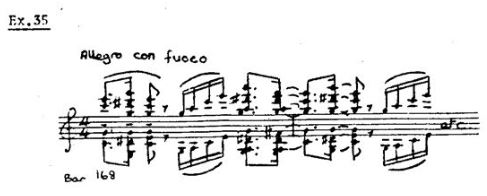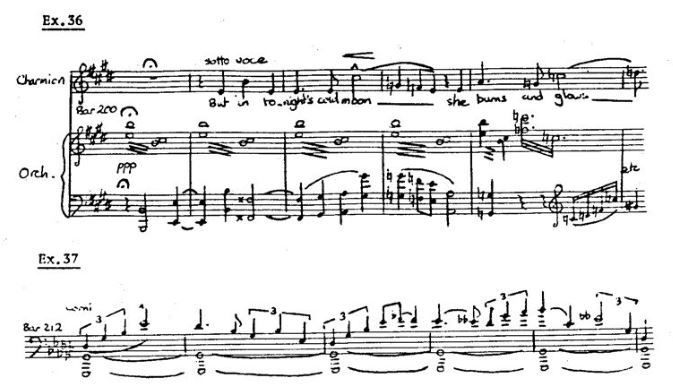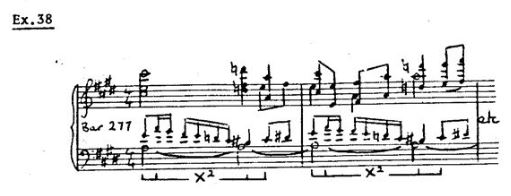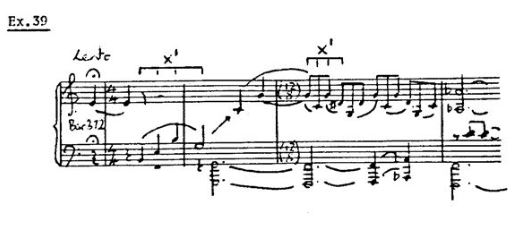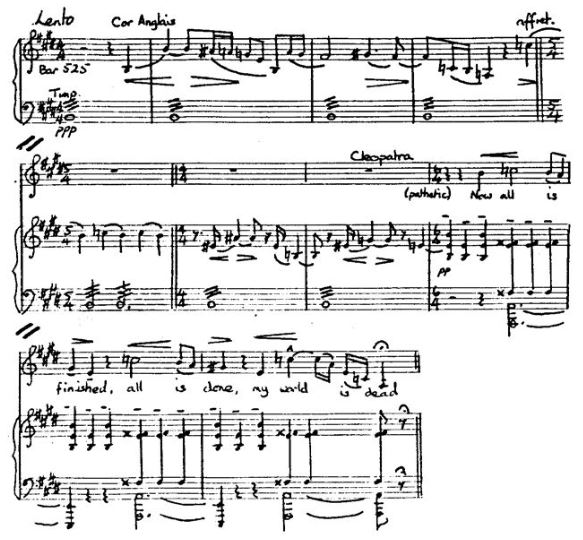Neil Starling
At bar 136 the small chorus makes its first appearance. It has a very short passage of only nine bars, and the texture is completely homophonic. There is very little accompaniment, mainly consisting of the C# pedal from the Slave Dance. The choral passage is closely related to the work’s opening orchestral movement, having the falling movement through G#, F## and F# which characterized Ex.29. The section ends with the glockenspiel playing C# and G# quavers over a span of two octaves, suggesting the first three notes of X.
The section for small chorus is followed by another aria for Iris, and this is based on the same two motives as her previous passage. The central part of the solo contains a canonic treatment of X2, now in C major, and with the first note an octave higher. The solo ends with a new presentation of X2, this in an almost unrecognisable form, though it contains all the notes of X2.
The first three notes of X2 are in the opening tonic chord of Ex.35, while the appoggiatura (D# - E) is contained in the following two chords. The rising semiquaver line suggests the semiquaver arpeggio of bars 4 and 6 of Ex.32. The end of Iris’s solo overlaps with the next section for small chorus, which is also introduced by Ex.35. The accompaniment of the chorus consists of arpeggio figuration (probably on violins) on A and D, clearly derived from the first three notes of X. The opening of the choral material itself also consists of-upward movement through A, D and A, again suggesting the first three notes of X. The appoggiatura movement is also implied, but instead of the fall to E# which would be required for an accurate presentation of X2, there is instead a fall of a 7th to B.
The choral writing is again very straightforward. Except for some independence of parts between altos and basses in the last three bars, the section consists entirely of soprano/ tenor and alto/bass doubling. Even when individual parts divide there is still the doubling between male and female voices. This vocal style which uses much octave doubling may be a result of Brian’s work as an organist. On this instrument it is normal for parts to be constantly doubled because of the use of the varying stops, and Brian may have transferred this technique, either consciously or subconsciously, to the chorus.
The imitative opening of the chorus soon changes to a homophonic texture during the mere eight bars of the section, and the voices end on a bare 5th, in typical Brian style. During the last two bars of the chorus the orchestra announces X in the bass, with the figuration on the violins continuing. This leads to Charmion’s second and final solo. The first six bars are characterized by statements of X2 in semi-quaver triplets and descending chromatic runs. At bar 191 the material of Ex.35 returns, but this is short-lived, because at bar 198 the music turns to the theme from the Slave Dance, as in Charmion’s previous aria. This is immediately followed by a mysterious passage where X2 is presented under a tremolando on the added 6th chord of E (with the 3rd missing), evoking the atmosphere of the words “But in tonight’s cold moon she burns and glows” (Ex.36). The last five notes in the bass of Ex.36 can be seen to outline X (ignoring the D’), and seven bars later Charmion’s aria draws to a close. Another section for small chorus follows, this time only four bars long. The texture is again in two parts, with octave doubling between male and female voices. The chorus is accompanied by a memorable horn melody over a Gb pedal (Ex.37).
This melody is immediately repeated in canon, to begin Iris’ final aria, where it accompanies the words “The day has gone, and soon they’ll drink the heady wine which sparkles in each other’s eyes”. At this point there is an orchestral inter-lude of 17 bars, and both XI and X’ are prominent. This material continues until the end of Iris’s solo, which is followed by another section for small chorus. This is again only eight bars long, and is, until the last three bars, in two parts with octave doubling. These two parts are imitative, becoming homophonic when the texture splits into four, then eight parts. As with the second chorus, the bass of the orchestra enters with a version of X at the end of the passage. This marks the end of the first vocal section of the work.
The second section consists of a duet between Antony and Cleopatra. Antony’s entrance is marked by a bold trumpet fan-fare, and Antony is instructed to sing his first line “with great earnestness and enthusiasm”. A theme is then presented which comes to be associated with Antony, although it contains in its inner parts an allusion to X2 (Ex.38).
Cleopatra’s next entry again clearly states X in its first five notes, this time over a C and G bare 5th, reminding us of the work’s opening. In the fifth bar of Cleopatra’s solo the theme associated with her appears in its most complete form since its first appearance at bar 87. Here it corresponds to bars 3-7 of Ex.32. This is the only occasion in the work, after its first appearance that the theme appears in a more complete state than its first five notes. By contrast, Antony’s next verse in the duet presents X in its most truncated form, as two chords, the first consisting of the first three notes of X (B,E,B), and the second containing the “appoggiatura” note (F##), which remains unresolved. His next verse restates Ex.38.
Most of Cleopatra’s vocal lines throughout the duet tend to be shaped by X, either in the five-note X’ version, or just the first three notes of X. The truncated two-chord form of X makes several subsequent appearances and the “Allegro con fuoco” version (Ex.35) also reappears. At the climax of the duet both voices sing simultaneously, beginning with independent parts, but soon singing in octaves. This is accompanied by a grandiose version of Antony’s theme (Ex.38), more complex in its texture than on any other presentation. The duet ends with repeated chords hammered out in semiquavers, while X is again presented in the bass. In typical Brian style the music works up to a great crescendo, and is cut off suddenly, to resume very softly as the beginning of the next main section of the work. Cleopatra’s aria “Far back within the womb of time” is introduced by two versions of X (Ex.39).
The first half of the solo is based mainly on the quaver rocking motion of Ex.39, along with syncopated repeated chords. The second half of the solo, beginning with the words “Whence slowly crept upon dreams” (bar 410), is introduced by a distant, subdued version of the fanfare which introduced Antony, preparing us for Cleopatra’s lament upon the death of her lover. Again, the vocal lines are shaped by the first three notes of X, and the truncated, two-chord form of X is also present. The solo ends with the orchestra restating X2 followed by the horn melody of Ex. 37.
At this point the full chorus makes its first appearance, with the words “Great silence is o’er everything”. The tranquillity of silence is very well portrayed by the pure diatonicism of the passage, in direct contrast to the extreme chromaticism of everything that has gone before. The orchestral texture of this opening part of the chorus consists of arpeggios on the tonic added-6th chord with semiquaver running motion underneath, and a tonic pedal in the bass to make the tonality of the passage even more definite. The music returns to chromaticism when Brian feels that the words demand it, at the words “In our blood there is a sting, urging to love, both slave and king”. The reappearance of chromaticism is accompanied by an increase in the complexity of the vocal texture. The chorus opens very softly with the altos and basses in unison, with the sopranos and tenors entering in canon. For the first 17 bars the voices are never in more than two parts, but at this point all four voices enter, though with Brian’s customary octave doubling. At bar 486 the texture divides into eight parts, but there is some octave doubling. At bar 491 the small chorus provides a contrast at the words “Oh, for the secrecy of night”. As with all of the other sections for the small chorus, this is very short, lasting only seven bars. A short passage with the glockenspiel playing an arpeggio figure derived from the first three notes of X leads to the next section for full chorus, where the words “For we are feverish with the thirst” are depicted by staccato quavers in four parts of the divided chorus, while the sopranos and first tenors sing the melody. The chorus ends on a great climax, and the music subsides for the beginning of the final rain section of the work. This begins with a lament for cor anglais, which introduces Cleopatra’s despairing solo “Now all is finished, all is done, my world is dead”, which is accompanied by the truncated two-chord form of X1 (Ex.40).
This section of the work is the most melodious and rewarding passage for a soloist, with arching melodic curves, instead of the angular lines of the previous sections, which even the most accomplished singers would find taxing. The first part of the solo introduces the truncated form of X, and also at bar 547 the theme of the Slave Dance appears. At the point where Cleopatra sings of Antony “His eyes have tears they cannot shed, his tale is told”, the theme which is associated with Antony appears, and, in counterpoint with it, elements of the cor anglais lament (Ex.40, bars 1-4) can be found. At bar 570 both the words and the music of “Now all is finished, all is done” are repeated. At the words “Whence springs neither love nor bitterness” the vocal material is new, but it is accompanied in the orchestra by statements of X2, and this forms a coda to the solo, so the whole aria is in the form A-B-A-Coda.
The work closes with a Marche Funèbre for the main chorus, with a very short passage for the basses of the small chorus. The music for this funeral march is based on the Slave Dance, and is therefore in 6/4 time, a rather unusual metre for a march. Apart from the first five bars where there is only one vocal part singing at a time, the choral textures are almost completely homophonic. A short recitative by the basses of the chorus leads to a 12-bar orchestral interlude, which is followed by the final choral entry, “Two suns have gone away to sleep”, to the same material which had previously presented the words “The sun has gone away to sleep”. This builds up to a great climax which subsides in the orchestra in the final bar, where the closing cadence comprises the two chords which were a feature of the work’s opening, with the sounding against the CU pedal. As at the beginning of the composition, the final tonic chord has no 3rd.
Like Brian’s two major psalm settings, Brian feels the need to close the work with a recapitulation, or at least, with a brief reminder of the material which opened the composition. Even in a work such as The Vision of Cleopatra, where the text dictates a freer attitude to formal construction, Brian attempts to apply formal principles as rigorously as possible, both in the use of this recapitulation device, and also in the constant use of a motif which permeates almost the whole of the music in its various forms.
© 1985 Neil Starling
Newsletter, NL 59, 1985
